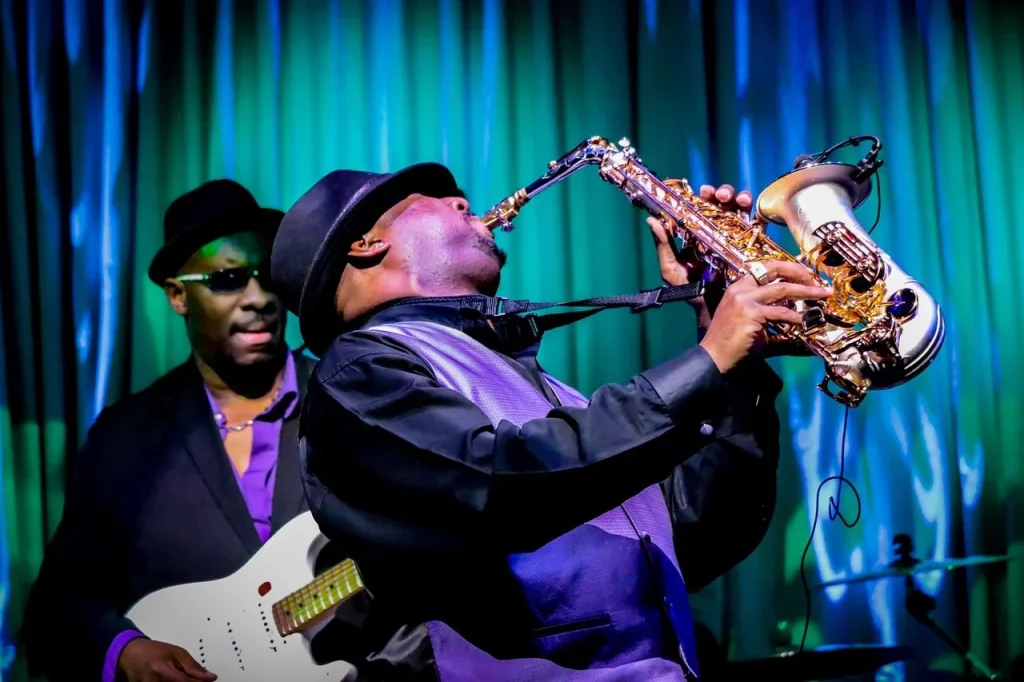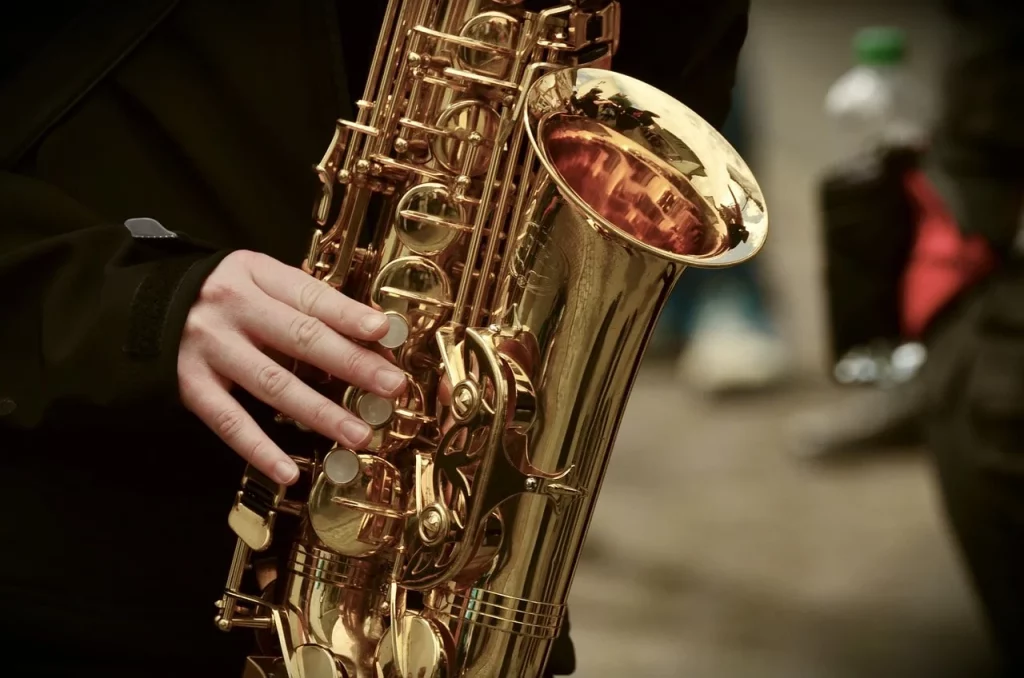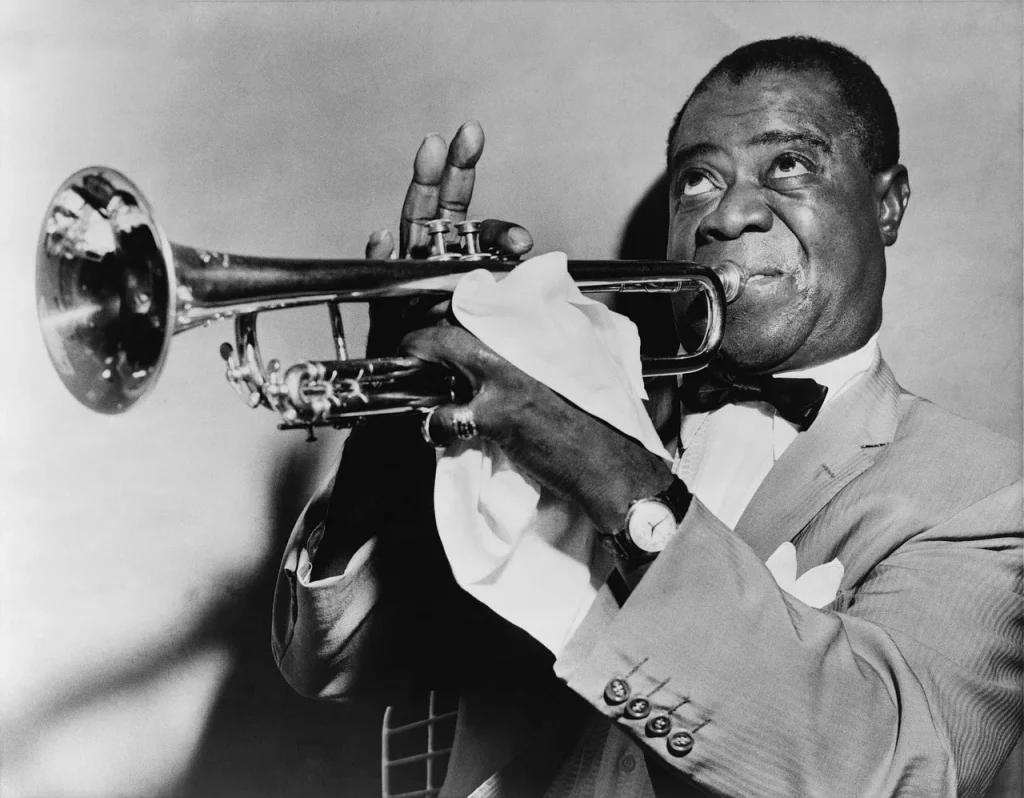Step into the time machine, folks, as we swing back to the era of jazz, a time when music wasn’t just heard but felt in the bones. Jazz is like that friend who is predictably unpredictable, always keeping you on your toes, much like my dog when he sees a squirrel.
It’s a genre that refuses to stay within the lines, coloring outside the musical borders with every note. But what is it about jazz that captures our hearts and ears, decade after decade? Let’s find out.
Jazz is not just music, it’s a way of life, it’s a way of being, a way of thinking.
Nina Simone
Jazz Facts
Dive into the rhythm and soul of jazz, and stay alert! At the end of this article, I created a quiz that will challenge your newfound knowledge. Read on to become a jazz master.
- Jazz originated in the African-American communities of New Orleans, United States, in the late 19th and early 20th centuries.
- It’s often characterized by syncopated rhythms, polyphonic ensemble playing, and the use of original timbres.
- Improvisation is a key element of jazz; musicians often make up their solos on the spot.
- The word “jazz” likely derives from the slang term “jasm,” meaning energy or pep.
- Louis Armstrong, a trumpeter from New Orleans, is often credited with transforming jazz from a collective improvisation to a solo performance.
- Bebop emerged in the 1940s and is characterized by fast tempos and complex harmonies.
- Jazz has deeply influenced other music genres like rock and classical.
- The first jazz recording was made by the Original Dixieland Jass Band in 1917.
- Swing music, a form of jazz, became popular during the 1930s and was associated with dance.
- Notable jazz festivals include the Newport Jazz Festival and the Montreux Jazz Festival.
- Miles Davis’s album “Kind of Blue” is one of the best-selling jazz records of all time.
- Modal jazz is a style that uses musical modes rather than chord progressions as a harmonic framework.
- The saxophone and trumpet are among the most iconic jazz instruments.

- Jazz influenced the civil rights movement, with artists creating works to address social issues.
- Ella Fitzgerald is renowned for her scat singing and impeccable vocal improvisation.
- Chicago became a jazz hotspot in the 1920s, especially for the development of Dixieland jazz.
- Jazz has a rich tradition of standards and songs widely known and performed.
- Free jazz, emerging in the 1950s, broke away from traditional jazz structures.
- The banjo was a common rhythm instrument in early jazz bands.
- Jazz has evolved into numerous subgenres, including smooth jazz, Latin jazz, and acid jazz.
- Duke Ellington is known for his contributions to big band jazz.
- Jazz was heavily influenced by African rhythms and European harmonic structure.
- The Blue Note record label is famous for its extensive jazz recordings.
- Jazz musicians often engage in “call and response” patterns.
- John Coltrane’s album “A Love Supreme” is considered a masterpiece in jazz.
- Hard bop emerged in the 1950s, blending R&B, gospel, and blues influences with jazz.
- Jazz has significantly contributed to the evolution of dance styles and fashion.
- The use of the piano in jazz has evolved from ragtime to complex modal harmonies.

- Fusion jazz, combining jazz with other genres like rock, emerged in the 1960s.
- Jazz clubs have played a vital role in the development and dissemination of the genre.
- The Bossa Nova style from Brazil blends samba and jazz.
- Thelonious Monk is known for his distinctive piano style and contribution to jazz composition.
- Jazz has been a vehicle for social and political commentary throughout its history.
- Billie Holiday’s unique voice and phrasing made her one of the most influential jazz vocalists.
- Scat singing involves vocalizing using nonsensical syllables instead of words.
- The big band era of the 1930s and 1940s featured large jazz orchestras.
- Jazz fusion often incorporates electric instruments and rock rhythms.
- Jazz education has become a significant part of music education in schools and universities worldwide.

- The Apollo Theater in Harlem played a major role in the Harlem Renaissance and jazz history.
- Many jazz musicians have been known for their distinctive personal style and charisma.
- Latin jazz combines rhythms from African and Latin American countries with jazz harmony.
- Some jazz artists have delved into avant-garde and experimental music.
- Jazz has been a major influence on film music and soundtracks.
- Weather Report and The Mahavishnu Orchestra were prominent bands in the fusion jazz scene.
- Charlie Parker, a key figure in bebop, was known for his fast playing and improvisational skills.
- Several jazz musicians have received the Pulitzer Prize for music.
- Jazz has contributed to the development of recording technology and studio techniques.
- Acid jazz combines elements of jazz, soul, funk, and disco.
- Jazz clubs, like the Cotton Club in Harlem, were important cultural hubs.
- Cool jazz, which emerged in the late 1940s, features relaxed tempos and a lighter tone.
Jazz Myths

Having explored all these fun facts about jazz music, we now move on to the next section. It’s time to distinguish fact from fiction.
- Jazz is Purely Improvisational
While improvisation is a key element, it also heavily relies on structure, theory, and composition. Standards, chord progressions, and rhythm patterns form the backbone around which improvisation occurs. It’s not just random notes; it’s skilled musicians communicating within a framework. - Jazz is an American Genre Only
Originating in America, jazz has become a global phenomenon. Influences from various cultures have been integrated into jazz, and it has evolved differently in countries around the world. This global exchange has enriched the genre, making it more diverse and vibrant. - All Jazz is Old-Fashioned
Jazz is not confined to its historical roots. Contemporary jazz artists continually innovate, blending jazz with modern genres like hip-hop, electronic, and pop. This evolution ensures that it remains relevant and fresh, attracting new audiences. - Jazz Musicians are Untrained
Many jazz musicians are highly trained and knowledgeable about music theory. Their ability to improvise is often rooted in a deep understanding of musical structure, scales, and harmony. Formal education in jazz is common, with numerous prestigious institutions dedicated to its study. - Jazz is Easy to Play
Playing requires a high level of skill and understanding. Musicians must master their instruments, have a strong grasp of timing and rhythm, and be able to communicate effectively with other band members.
No products found.
Jazz Quotes

Jazz, a symphony of improvisation and rhythm, has captivated hearts and minds for generations. Below, you will find some of my favorite quotes about this music genre. If you want to add some to the list, just let me know in the comments.
If you have to ask what jazz is, you’ll never know.
Louis Armstrong
Louis Armstrong, a legendary jazz trumpeter and vocalist, implies the ineffable and instinctive nature of jazz, suggesting that its understanding is more about feeling than explanation.
Jazz is about being in the moment.
Herbie Hancock
Herbie Hancock, an influential jazz pianist and composer, highlights the improvisational and present-focused spirit that is at the heart of jazz music.
The thing to judge in any jazz artist is, does the man project and does he have ideas.
Miles Davis
Miles Davis, a pivotal figure in the world of jazz, emphasizes the importance of individual expression and innovation in a jazz musician’s artistry.
Jazz music is the power of now. There is no script. It’s conversation. The magic happens in the moment.
Wynton Marsalis
Wynton Marsalis, a renowned trumpeter and composer, captures the dynamic and spontaneous nature of jazz, likening it to a lively, unscripted conversation.
Life is a lot like jazz… it’s best when you improvise.
George Gershwin
George Gershwin, a famous composer known for his jazz-influenced works, draws a parallel between jazz and life, underscoring the art of improvisation and adaptability in both.
Jazz FAQ

You’ve journeyed through the soulful world of jazz quotes. Now, focus on the FAQs ahead; they’re your stepping stones to success in the quiz that awaits.
- How did jazz start?
Jazz is a music genre that originated in the African-American communities of New Orleans, United States, in the late 19th and early 20th centuries. It developed from roots in blues and ragtime. Jazz is often characterized by its use of blue notes, improvisation, swing, call and response, and complex rhythms. - Are jazz and blues the same?
While jazz and blues are closely related and share some similarities, they are not the same. Blues is a music genre that originated in the African-American communities of the Deep South of the United States around the end of the 19th century. Jazz, on the other hand, evolved from blues and ragtime but is more complex, often incorporating improvisation, complex chords, and rhythms. Jazz uses the blues as a foundation but expands with more diverse harmonies and freer form. - What are the key elements of jazz?
The key elements of jazz include improvisation, which is at the heart of jazz performance; complex and often syncopated rhythms; and a unique tonality that often includes swing and blue notes. Another element is the call and response pattern, originating from African music traditions. - Who are some of the most influential jazz musicians?
Jazz has been shaped by many great musicians. Louis Armstrong, a trumpeter and vocalist, is often credited with turning jazz into a soloist’s art. Duke Ellington, a composer, pianist, and bandleader, elevated jazz to an art form comparable to classical music. Miles Davis, known for his innovative and influential work, played a significant role in the development of modern jazz. Ella Fitzgerald and Billie Holiday, with their unique vocal styles, are considered two of the greatest jazz vocalists. - How has jazz influenced other music genres?
Jazz has profoundly influenced many other music genres, including rock and roll, R&B, and hip-hop. Its improvisational style and harmonic complexity have seeped into the DNA of many modern genres. Jazz chords and improvisation techniques are commonly found in modern pop music. The genre’s influence on rock is particularly notable in the work of artists like The Beatles and Frank Zappa.
No products found.
Jazz Trivia

Welcome to the ultimate jazz quiz! Get ready to swing through these questions, but beware; if you miss them all, you might find yourself stuck in an endless loop of elevator jazz music!
Conclusion
In conclusion, diving into the fascinating world of jazz has been a truly enriching experience. From its origins in the vibrant streets of New Orleans to its worldwide influence, the genre has left an indelible mark on music history.
We’ve explored its unique rhythms, improvisation, and the genius of jazz legends who’ve shaped its evolution. But before we wrap things up, I have to ask: Did you ever try to snap your fingers to the intricate beats of a jazz tune? Let me know in the comments.
8 Sources Used For This ArticleExploring the Roots of Jazz Music – Blog Daisie
How American Classical Music Influenced Jazz – Walnut Creek Band
I Like Jazz Music – Bart Leby
50 Unbelievable Facts About Jazz – At Once
Is Jazz is the Number 1 Music Today in America? – Slo Jazz Festival
Exploring The Evolution Of Jazz Dance – Passada
How Jazz Music Originated In New Orleans – Walnut Creek Band


